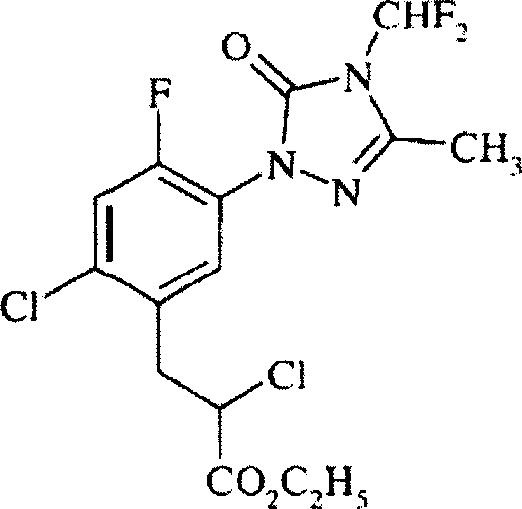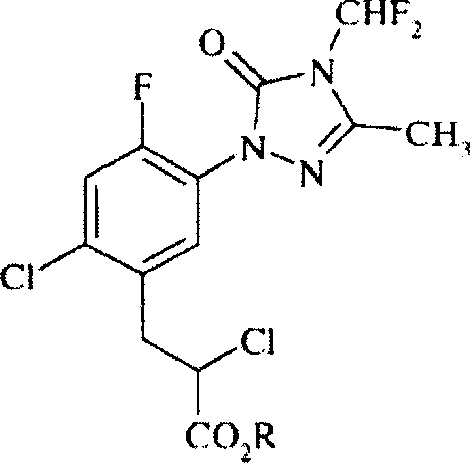Method for control of ground shoots of vines and other trunk vegetation
A vine and ground technology, applied in botany equipment and methods, plant growth regulators, animal repellants, etc., can solve problems such as poor safety level, high application rate, slow onset of action, etc.
- Summary
- Abstract
- Description
- Claims
- Application Information
AI Technical Summary
Problems solved by technology
Method used
Image
Examples
Embodiment 1
[0032] Efficacy test of carfentrazone-contrane on harmful ground branches of vines
[0033] The test was carried out as follows: 12-36 g / hl of carfentrazone formulated as 60ME (equivalent to 0.2-0.6 l / hl of SPOTLIGHT PLUS 60ME containing 60 g / l of carfentrazone in the composition) was sprayed on vine branches. Lianas were evaluated periodically after application. The percent control or efficacy (%) was determined as the percent reduction in volume of vine shoots after spraying compared to the untreated reference. 4 trials were performed.
[0034] The results are shown as the mean of 4 trials, compared to those observed in the same trials with 1.0 l / hl diquat (Reglone 2) and 1.4 l / hl paraquat (Gramoxone Plus). Results and comparisons are shown in Table 1 below.
[0035] ratio
[0036] DAT = days after treatment
Embodiment 2
[0038] Efficacy of a second application of carfentrazone on harmful ground shoots of vines
[0039] The test was carried out as follows: 12-18 g / hl of carfentrazone formulated as 60ME (equivalent to 0.2-0.3 l / hl of SPOTLIGHT PLUS 60ME containing 60 g / l of carfentrazone) was sprayed on vine branches. A second application was given 30 days later. Lianas were evaluated periodically after the second spraying. The percent control or efficacy (%) was determined as the percent reduction in volume of vine shoots after spraying compared to the untreated reference. 4 trials were performed.
[0040] Results are shown as the mean of 4 trials, as observed in the same trials with 2 x 1.0 l / hl diquat (Reglone 2) and 2 x 1.4 l / hl paraquat (Gramoxone Plus) at 30 day intervals compare the results. Results and comparisons are shown in Table 2 below.
[0041] ratio
[0042] DAST = days since second treatment
Embodiment 3
[0044] Efficacy test of carfentrazone on harmful ground branches of plum tree
[0045] The test was carried out as follows: 12-27 g / hl of carfentrazone formulated as 60ME (equivalent to 0.2-0.45 l / hl of SPOTLIGHT PLUS 60ME containing 60 g / l of carfentrazone) was sprayed on ground branches of plum trees. Plum trees were evaluated periodically after application. The percent control or efficacy (%) was determined as the percent volume reduction of ground shoots after spraying compared to the untreated reference. Three trials were performed.
[0046] The results are shown as the mean of 3 experiments, compared to the results observed in the same experiment with 1.25 l / hl gluphosinate (BastaF1). Results and comparisons are shown in Table 3 below.
[0047] ratio
[0048] DAT = days after treatment
PUM
 Login to View More
Login to View More Abstract
Description
Claims
Application Information
 Login to View More
Login to View More - R&D
- Intellectual Property
- Life Sciences
- Materials
- Tech Scout
- Unparalleled Data Quality
- Higher Quality Content
- 60% Fewer Hallucinations
Browse by: Latest US Patents, China's latest patents, Technical Efficacy Thesaurus, Application Domain, Technology Topic, Popular Technical Reports.
© 2025 PatSnap. All rights reserved.Legal|Privacy policy|Modern Slavery Act Transparency Statement|Sitemap|About US| Contact US: help@patsnap.com


